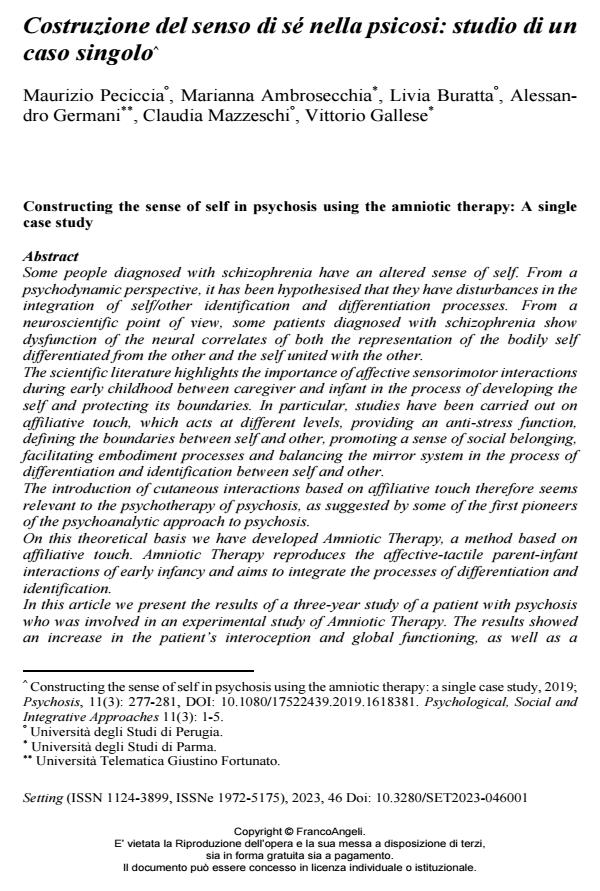Costruzione del senso di sé nella psicosi: studio di un caso singolo
Titolo Rivista SETTING
Autori/Curatori Maurizio Peciccia, Marianna Ambrosecchia, Livia Buratta, Alessandro Germani, Claudia Mazzeschi, Vittorio Gallese
Anno di pubblicazione 2024 Fascicolo 2023/46
Lingua Italiano Numero pagine 31 P. 5-35 Dimensione file 413 KB
DOI 10.3280/SET2023-046001
Il DOI è il codice a barre della proprietà intellettuale: per saperne di più
clicca qui
Qui sotto puoi vedere in anteprima la prima pagina di questo articolo.
Se questo articolo ti interessa, lo puoi acquistare (e scaricare in formato pdf) seguendo le facili indicazioni per acquistare il download credit. Acquista Download Credits per scaricare questo Articolo in formato PDF

FrancoAngeli è membro della Publishers International Linking Association, Inc (PILA)associazione indipendente e non profit per facilitare (attraverso i servizi tecnologici implementati da CrossRef.org) l’accesso degli studiosi ai contenuti digitali nelle pubblicazioni professionali e scientifiche
Alcune persone con diagnosi di schizofrenia mostrano un’alterazione del senso di Sé. Da una prospettiva psicodinamica, si è ipotizzato che abbiano disturbi dell’integrazione dei processi di identificazione e differenziazione del Sé/altro. Da un punto di vista neuroscientifico, alcuni pazienti con diagnosi di schizofrenia pre-sentano disfunzioni nei correlati neurali sia della rappresentazione del Sé differen-ziato dall’altro sia del Sé unito all’altro. La letteratura scientifica sottolinea l’importanza delle interazioni affettive sensori-motorie durante la prima infanzia tra il caregiver e l’infante nel processo di svilup-po del Sé e di protezione dei suoi confini. In particolare, sono stati condotti studi sul tatto affiliativo che agisce a diversi livelli, svolgendo una funzione antistress, defi-nendo i confini tra Sé e l’altro, promuovendo il senso di appartenenza sociale, facilitando i processi di embodiment e bilanciando il sistema specchio nel processo di differenziazione e identificazione tra Sé e l’altro. L’introduzione di interazioni cu-tanee basate sul tatto affiliativo sembra pertanto rappresentare un aspetto signifi-cativo della psicoterapia delle psicosi, come suggerito da alcuni pionieri del trat-tamento psicoanalitico delle psicosi. Sulla base di queste fondamenta teoriche, abbiamo sviluppato un innovativo approccio noto come Terapia Amniotica, che fa uso del tocco affiliativo. Questa tera-pia mira a replicare le interazioni affettivo-tattili tra il genitore e il neonato, specifiche della prima infanzia, e ha come obiettivo l'integrazione dei processi di diffe-renziazione e identificazione. In questo articolo, condivideremo i risultati di una ricerca condotta nell’arco di tre anni, centrata su un paziente affetto da psicosi, coinvolto in uno studio sperimentale incentrato sulla Terapia Amniotica. I risultati emersi dall’indagine hanno mostrato un notevole miglioramento dell’interocezione e del funzionamento complessivo del paziente, accompagnato da una significativa riduzione dei sintomi positivi della psicosi. Questo suggerisce che la Terapia Amniotica possa contribuire al potenzia-mento dei confini del Sé del paziente e all’integrazione dei processi di identificazio-ne e differenziazione.
Parole chiave:Psicosi, Sé corporeo, tocco affiliativo, interocezione, sistema specchio, terapia amniotica
Maurizio Peciccia, Marianna Ambrosecchia, Livia Buratta, Alessandro Germani, Claudia Mazzeschi, Vittorio Gallese, Costruzione del senso di sé nella psicosi: studio di un caso singolo in "SETTING" 46/2023, pp 5-35, DOI: 10.3280/SET2023-046001